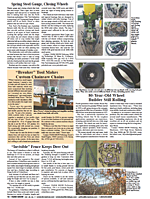You have reached your limit of 3 free stories. A story preview is shown instead.
To view more stories
(If your subscription is current,
click here to Login or Register.)
Mullein Used In Home Remedies
A misunderstood weed might be free medicine for your family. Mullein, a hairy, herbaceous biennial, grows over 8 ft. tall. Youíll recognize it by its small yellow flowers along the tubular central stalk and the large, fuzzy leaves at the base. These are plants in their second year, since the stalk and flowers wonít app
..........
You must sign in, subscribe or renew to see the page.

You must sign in, subscribe or renew to see the flip-book
Mullein Used In Home Remedies
A misunderstood weed might be free medicine for your family. Mullein, a hairy, herbaceous biennial, grows over 8 ft. tall. Youíll recognize it by its small yellow flowers along the tubular central stalk and the large, fuzzy leaves at the base. These are plants in their second year, since the stalk and flowers wonít appear before then.
Mullein is native to Europe, North Africa and Asia, and itís widespread across Australia and North America. The scientific community knows it as Verbascum thapsus, but itís more commonly called velvet plant, candlewick, shepherdís staff and beggarís stalk.
For centuries, mulleinís been a popular herbal remedy for tonsillitis, bronchitis, emphysema and tuberculosis, as well as stomach and intestinal infections. The leaves contain mucilage, a gel-like substance that soothes inflamed mucous membranes. Dry the leaves to make a tea that helps suppress colds and coughs. Some mullein fans even find it helpful for slipped discs and bone problems.
Compounds in mullein have cough-relieving and mucus-thinning properties. One of its compounds, ursolic acid, shows evidence of preventing and treating COVID-19. Itís typically consumed as an infusion or syrup, often combined with mint, rosemary, hawthorn flower or pine leaves. Apply it directly to the skin to treat burns and wounds.
Mulleinís purpose can also be less medicinal. Dried, the leaves serve as an excellent fire starter, and history shows that ancient Romans used the flowers as a yellow hair dye. Only a few flowers bloom on each stalk daily, so leave the plant undisturbed while harvesting some.
Contrary to popular belief, mullein is quite common. You can find it almost anywhere with disturbed soil, especially if itís chalky, sandy or has a lot of gravel. This often includes pastures, fields and roadsides. Plants growing near roads are likely contaminated with chemicals and are not suitable for any medicinal purpose.
To grow your own, plant mullein seeds in full sun after the last risk of frost. Itís intolerant of shade and will be quickly outgrown by other plants in that area. Cover the seeds with a thin layer of soil, pressing them firmly into the ground. The young plants need at least an inch of water each week. Expect them to flower in the second year, then die soon after.
The plants arenít considered aggressive because they only spread in disturbed soil. Still, theyíre known for taking over roadsides and construction sites due to their short lifespan. After that, the seeds go dormant in the ground, waiting for the next soil disturbance to germinate, sometimes decades later. Research from Michigan State University shows germination is possible after a hundred years. So, if you find a clump you can use, scatter the seeds in scuffed-up soil. That guarantees youíll have plenty to harvest for years to come.
To read the rest of this story, download this issue below or click
here to register with your account number.





